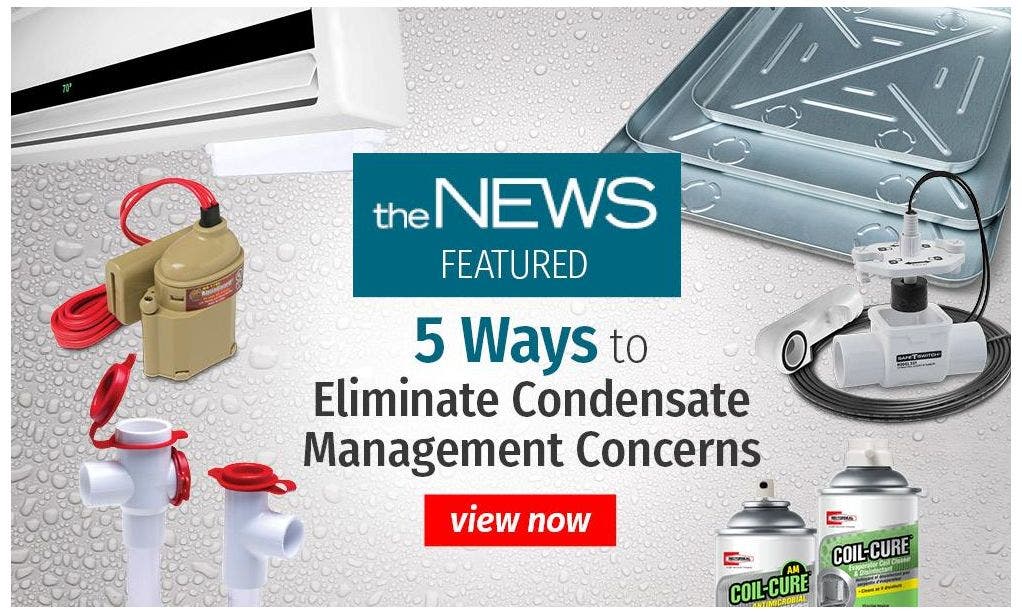Say goodbye to condensate management problems
Proper condensate management is not only part of a professional HVAC installation but also a requirement of the International Mechanical Code (IMC 307.2.3). A nonexistent or inadequate condensate management system can result in extensive water damage to a home or business. It’s been reported that due to water damages, average homeowner claims have surpassed $10,000 per claim (Source: https://www.iii.org/fact-statistic/facts-statistics-homeowners-and-renters-insurance) underscoring the impact of improper condensate management. Not only does ineffective condensate management result in potential damage to a home or business, but it can also severely impact the reputation of an HVAC technician’s company. Fortunately, there are a variety of options that will help to eliminate any condensate management concerns. Take a quick review of the available solutions and say goodbye to condensate management problems.
1. Protection – Condensate Pans
Condensate pans are a simple yet essential component of condensate management. They are designed to capture condensate and transfer it out of the area around the HVAC system into a drain line ending safely outside a structure. Available in a variety of materials including ABS, metal, plastic, and composites, condensate pans offer both rigid and flexible constructions. Many are available in single-piece configurations. Depending on the construction material, many pans feature a network of built-in risers that are compatible with a variety of HVAC units. Condensate pans offer outstanding durability and are crack resistant. Select models are code compliant when required for high or extreme heat installations. Many pans are designed for compatibility with condensate switches or pumps.
2. Detection – Condensate Switches
Low voltage switches are designed to detect clogged condensate drains. They are easy to install and are available in plenum-rated models too. Designed for ducted and ductless HVAC systems, condensate switches offer flexible installation and easy access for routine maintenance. Condensate switches can be mounted in drain lines, auxiliary drains, or in condensate pans. Low-profile units are available to accommodate even the tightest installation spaces.
3. Removal – Condensate Pumps
Condensate water runs downhill, but sometimes it needs a little help on its journey. Condensate pumps are available for ducted and ductless HVAC systems. Both are designed to provide automatic condensate removal controlled by a float switch mechanism. Many tank units are activated when as little as 2 ¼ inches of condensate is detected and will shut off when the condensate level drops below 1 ¼ inch. Reservoirs holding up to one-half gallon of condensate help ensure optimal performance. Tank pumps provide an economical condensate removal solution along with added durability and reliability.
Ductless condensate pumps offer quiet operation to help to eliminate concerns regarding operational sound in living areas where ductless cassettes are installed. Many ductless condensate pumps are color coordinated to match many HVAC brands. Slim profile designs complement all leading residential and commercial HVAC manufacturers. Select condensate pumps have soft-start capacitance technology to optimize the pump speed, driven by a fully variable speed
motor, in response to the HVAC unit’s flow rate.
4. Clearance - Fast Blockage Removal
Even with the installation and use of pumps, switches, and chemical solutions, condensate lines can become clogged. Fortunately, multiple options exist that provide fast, safe, and convenient blockage removal. As HVAC manufacturers migrate to all-aluminum evaporator coils, condensate management becomes more important as aluminum coils are more susceptible to oxidation than copper-aluminum coils.
A burst of CO2 can quickly clean condensate drain lines. Select CO2 condensate removal units include a flexible hose to maneuver easily in tight spaces and are compatible with Shrader valves. CO2 systems are portable, lightweight, and environmentally friendly.
Hand-operated air pumps offer condensate blockage removal without the need for electricity, nitrogen, or gas cartridges. Select pumps are constructed of heavy-duty molded PVC and are reusable. They can be pumped and pressurized quickly and are ready to connect to clean-out access ports for action. Air pumps clean the most stubborn clogged condensate drains. Some pump models are reversible and can be used to vacuum or flush materials from a clogged drain line. Air pumps are useful for removing standing water from condensate pans too.
5. Prevention – Chemical Solutions
When environmental conditions are favorable, condensate drains can clog due to a combination of fungus, bacterial slime, rust, scale, sludge, airborne dust, silt, other solids, or a blend often referred to as white slime. Several chemical solutions are available that will help clear any blockages and help keep condensate drains free from white slime.
Tablets can be placed directly in the condensate drain pan to help remove blockages over the life of the tablet which can last up to 3 months or longer. Many condensate treatment tablets are EPA registered for use in HVAC drain pans. Additionally, non-corrosive tablets are available that provide an alternative to chlorine tablets and bleach. When properly installed they can provide condensate drain protection for approximately 90 days or longer.
Beyond pan tablets, chemical solutions can be added directly to the condensate drain line for added protection. Simple one-time installation of a T body unit with a cartridge delivers a slow-releasing formula to provide condensate drain protection for up to 12 months. Both tablet and in-line chemical dispensers require no electrical components and select brands have a patent-pending design.
Evaporator coils are often the initial source of contaminants that lead to slow or blocked condensate drains. Cleaning and coating the coil can help reduce the growth of mold, fungus, and bacterial materials that can contribute to condensate drainage problems. By providing a clear coating without obstructing the efficiency of the evaporator coil, protective coatings can automatically release antimicrobial components such as copper and silver that can suppress bacterial growth. Select coatings are FDA, USDA, NSF, and CTFA listed and meet strict ecological and toxicological guidelines. Precautionary coatings can last up to 12 months, depending on the use of the HVAC system.
Please visit www.rectorseal.com for additional details, and follow us on LinkedIn, Facebook, YouTube, Instagram, and Twitter for the latest product enhancements and news.

